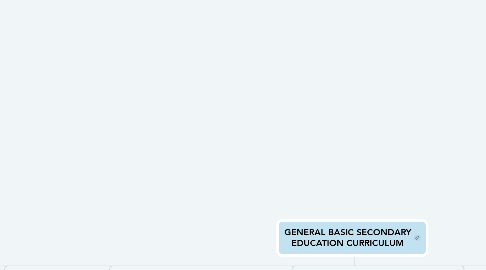
1. 21st Century skills developed through learning English
1.1. Global Engagement
1.1.1. Develop the understanding of the world
1.1.2. by students from other cultures and their own.
1.1.3. communicate their understanding and views to others through English
1.2. Social and thinking skills
1.2.1. Develop the necessary personal, social and intellectual skills
1.2.2. achieve their potential for productive participation.
1.2.3. in an increasingly globalised world operating in English
1.3. Foundation for lifelong learning
1.3.1. To create a love of learning languages starting at a young age
1.3.2. in order to foster learners’ motivation to continue learning
1.3.3. English throughout EGB and BGU, as well as work and beyond
1.3.4. by means of engaging and positive learning experiences
2. Curricular Threadsy
2.1. The three main goals of the EFL curriculum are:
2.2. To develop learners’ understanding of the world - of other cultures and their own - and to communicate their understanding and views to others through English.
2.3. To develop the personal, social, and intellectual skills needed to achieve their potential to participate productively in an increasingly globalized world that operates in English.
2.4. To create a love of learning languages starting at a young age, by means of engaging and positive learning experiences
2.5. To create a love of learning languages starting at a young age, by means of engaging and positive learning experiences,
2.6. 1) Communication and Cultural Awareness
2.7. 2) Oral Communication (Listening and Speaking)
2.8. 3) Reading
2.9. 4) Writing
2.10. 5) Language through the Arts.
3. Approach
3.1. The proposed EFL curriculum’s focus is communicative,
3.2. consistent with the intention expressed by the Ministry of Education Documents:
3.2.1. Within this approach, the proposal emphasizes the development of the four communicative skills rather than linguistic content learning.
3.2.2. because the goal of foreign language learning is not to turn learners into experts in linguistics who can conceptualize and decipher the various components of the language.
3.2.3. will be present [grammar, lexis, etc.], these should not be the main focus of the learning process.
3.2.4. Rather, the emphasis should be on the performative aspects of language as a means for engaging in purposeful communicative interaction and making meaning.
3.2.5. This is accomplished through a range of activities to support lively interaction
3.2.6. awakening learners’ consciousness and abilities, and creating positive engagement to support intrinsic motivation to learn English.
4. How English as a Foreign Language Contributes to the Exit Profile of Ecuadorian High School Students
4.1. The Ecuadorian High School Exit Profile aims to prepare Ecuadorian high school students for successful participation in a globalized, democratic society in the 21st century by focusing on the development of life skills, work skills, and entrepreneurship skills.
4.2. The EFL curriculum embraces the development of creative and critical thinking skills, as well as attitudes such as ethical conduct.
4.3. through the values of academic honesty and integrity
4.4. The skills are integrated within the five curricular threads, and encourage learners to act responsibly and to respect themselves as well as others while participating in the communication process.
4.5. English is considered the lingua franca of the science and technology community (Gordin, 2015)
4.6. being able to communicate in English opens up access to not only current and relevant information and primary sources.
4.7. but also communication with people from around the world.
4.8. The Oral Communication, Reading, and Writing curricular threads comprise specific skills that relate to the use of ICT to support and enhance the capacity for oral and written expression
4.9. facilitating organization, autonomy, and independence, along with other 21st century skills.
4.10. The EFL curriculum includes a thread called Communication and Cultural Awareness and another called Language through the Arts.
4.11. the Arts and Communication and Cultural Awareness threads also encourage the use of ICT to awaken intellectual curiosity and breed tolerance and interculturality through the use of authentic language.
5. CLIL
5.1. The methodology and classroom procedures to be applied when teaching within a CLIL model form part of the teaching and learning specifications of this curriculum.
5.2. CLIL models are diverse, making them flexible enough to be context-specific and complementary to a range of teaching methodologies
5.3. high levels of interaction between teachers and learners and learners themselves, intensive language input.
5.4. teacher modeling and scaffolding, and teacher enthusiasm (Coyle, 2007; ÇekreziBiçaku, 2011; Kilmova, 2012).
5.5. CLIL
5.5.1. Communication and Cultural Awareness
5.5.2. Oral Communication Speaking-Listening
5.5.3. Reading
5.5.4. Writing
5.5.5. Language through the Arts
6. The educación General Básica Media
6.1. It should be taken into account that although learners are expected to reach a certain level of English when graduating from Educación General Básica Media
6.2. In this case graduating from 7th EGB with an A2 level.
6.3. Consequently, learners in their first years of secondary education will be taught what they have already learned in terms of grammar and vocabulary, with new, context-specific vocabulary being added.
6.4. One of the main reasons for this being the case is the gap between stronger and weaker learners.
6.5. It also needs bearing in mind that when learners move from primary to secondary school, they also experience important changes in methodology and teaching approaches.
6.6. As primary learners, they are instructed mainly through games, songs, rhymes, and playful activities.
7. English as a Foreign Language and Content Language and Integrated Learning
7.1. Within a CLIL framework expressed as the 4Cs, language facilitates
7.2. 1) communication
7.3. 2) cultural awareness and understanding
7.4. 3) cognition
7.4.1. but they do share characteristics favorable to constructivist approaches and communicative language teaching (CLT).
